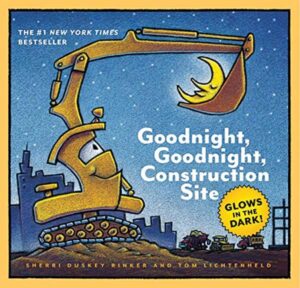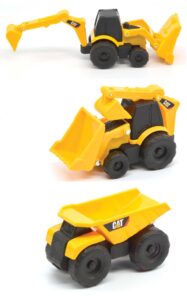Receptive language, Expressive language
Toddlers participate in a book sharing focused on bedtime practices of construction trucks with human-like characteristics.



Be Prepared: The popular book used in this activity offers rich illustrations with details that toddlers will need time and guidance to explore. The book text may be longer than some toddlers wish to process. Prepare for the session by deciding what book text to use in combination with your own words about the pictures.
 [Invite several toddlers to read a book about big trucks and bedtime. Begin by showing the book cover.]
[Invite several toddlers to read a book about big trucks and bedtime. Begin by showing the book cover.]
I think this is going to be a silly book. Trucks do not have eyes like we do. We usually see a moon up in the sky.
The story in our book happens at a construction site. A construction site is a place where something is being built, like a building or road. Our book tells about trucks that work at the construction site. The trucks are called construction trucks.
Construction is a big word! Let’s say together the word con-struc-tion.
[Lead toddlers in saying construction 1–2 times.]
Look at the dark sky on the cover of our book. It is bedtime. The construction trucks are getting ready to sleep.
Our book is called Goodnight, Goodnight, Construction Site. The trucks are saying goodnight to their construction site. Let’s find out how the trucks get ready for bedtime.
[Use the following strategies to share the story:
The trucks in our story worked hard all day. They were tired and ready to go to sleep. The trucks did some things at bedtime that we do. What is silly about this book?
This is a popular book among toddlers. The illustrations are appealing and the story theme of bedtime is one toddlers readily understand. Toddlers are likely to need your help in noticing some details of the illustrations. Pay close attention to the focus of their gazes and comments to determine how much guidance is needed.
The book is offered to younger toddlers (12–24 months) in Block 17, with the suggestion that a caregiver use his/her own words to describe the story and rich illustrations. The current activity assumes more of the book text, including novel words, can be shared with older toddlers.
Extra support
Enrichment
Receptive language, Expressive language
Toddlers describe and show how toy construction trucks featured in book illustrations work.



Be Prepared: This activity option is for toddlers who are familiar with the book through participation in Option 1 or a similar book sharing. Secure some toy trucks featured in the book, such as a crane truck, cement mixer, dump truck, bulldozer, excavator.
 Invite 3–4 toddlers to join you in working with trucks that are shown in the book Goodnight, Goodnight, Construction Site. Open the session by displaying the cover of the book and encouraging toddlers to help you tell what the book is about. Turn to pages associated with toddlers’ descriptions, as appropriate.
Invite 3–4 toddlers to join you in working with trucks that are shown in the book Goodnight, Goodnight, Construction Site. Open the session by displaying the cover of the book and encouraging toddlers to help you tell what the book is about. Turn to pages associated with toddlers’ descriptions, as appropriate.
Explain that the construction trucks shown in the book do important things. We can use toy trucks to show and talk about what trucks do. Give each toddler a truck.
Focus on one truck at a time. Turn to the book illustration(s) associated with a truck held by a toddler in the gathering. Say the name of the truck and use a combination of book text and your own words to describe how the truck works or what the truck does, as shown in the illustration(s). Below are examples:
 Crane truck: reaching, stretching, lifting high
Crane truck: reaching, stretching, lifting highInvite the toddler holding the corresponding truck to show how the truck works. Example: “Maya is holding a dump truck, just like the dump truck in this picture. Maya, would you like to show us how the truck can carry and dump things?” Encourage the toddler to describe what he/she is doing with the truck. Add descriptive information as appropriate. Example: “The part on the back of the truck is called a truck bed. When the truck bed is up, it dumps dirt or whatever the truck is carrying.”
Continue giving attention to each truck held by a toddler, beginning first with a description of the book’s illustration of the truck. Conclude the activity by explaining that we did two things to learn more about some construction trucks. We looked at pictures of trucks and used a play truck to show how the truck works.
This activity connects selected trucks featured in the book with items toddlers can hold and manipulate. The trucks offer a concrete way for toddlers to carry out actions associated with words they are learning.
Your important role in the activity is to facilitate each toddler’s contribution to the session. Avoid a scenario where you describe and the toddler demonstrates what you describe. It is beneficial for each toddler to be invited to talk about actions with the truck. Some toddlers will have more to say than others. Some may prefer to watch only.
Pace the attention to each truck so there is enough time for each truck to be discussed. Each toddler in the gathering deserves an opportunity to show and tell.
A potential learning outcome of the activity is the use of a book as a reference. Looking at selected pages and comparing an illustrated truck to a toddler’s actions with a similar toy truck demonstrate how we can use books for learning specific things. Books do not need to be read in their entirety to be helpful. This is a concept appropriate for exploration during preschool-age years, but early exposure to this use of books can happen informally as part of the activity.
Extra support
Enrichment
Materials needed: Goodnight, Goodnight, Construction Site by Sherri Duskey Rinker and Tom Lichtenheld, toy construction trucks used in Option 2
Place the book and the toy construction trucks in a defined area for toddlers’ continued exploration. Toddlers may want to play with a truck(s) managed by another child during the Option 2 activity or interact with the materials in different ways, such as building with blocks or driving the trucks. You may wish to add several other books about trucks or construction.
Materials needed: Goodnight, Goodnight, Construction Site by Sherri Duskey Rinker and Tom Lichtenheld, toy trucks used in Option 2, materials that can be manipulated during construction work
Preschool-age children may be interested in Options 1 and/or 2. Add safe play materials to the Interest Area activity that can be moved by or in toy trucks.